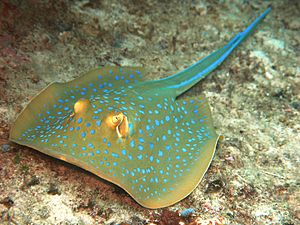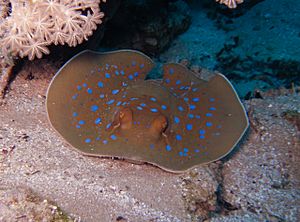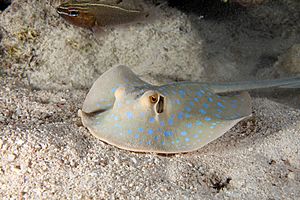Bluespotted ribbontail ray facts for kids
Quick facts for kids Bluespotted ribbontail ray |
|
|---|---|
 |
|
| Conservation status | |
| Scientific classification | |
| Genus: |
Taeniura
|
| Species: |
lymma
|
 |
|
| Range of the bluespotted ribbontail ray | |
| Synonyms | |
|
|
The bluespotted ribbontail ray (Taeniura lymma) is a beautiful species of stingray. You can find it in the warm, tropical waters of the Indian Ocean and the western Pacific Ocean. These rays usually live near coral reefs and sandy areas, from very shallow water down to about 30 meters (100 feet) deep.
This ray is quite small, growing to about 35 centimeters (14 inches) wide. It has a smooth, oval-shaped body and big eyes that stick out. Its tail is short and thick, with a fin-like fold underneath. What makes it easy to spot are its bright electric blue spots on a yellowish body. It also has two blue stripes along its tail.
At night, small groups of these rays swim into shallow sandy areas when the tide comes in. They use their bodies to search for small invertebrates and tiny fish hidden in the sand. When the tide goes out, they go back to hiding places in the reef. Bluespotted ribbontail rays give birth to live young, usually up to seven babies at a time. They have venomous (poisonous) tail spines, but they prefer to swim away if they feel threatened.
People sometimes keep these rays in home aquariums because they are so pretty and not too big. However, they often don't do well in captivity. The International Union for Conservation of Nature (IUCN) says this species is Near Threatened. This means their numbers are decreasing because their homes (coral reefs) are being damaged, and they are often caught by fishermen.
Contents
What's in a Name?
The bluespotted ribbontail ray was first described in 1775 by a Swedish naturalist named Peter Forsskål. He originally called it Raja lymma. The word lymma actually means "dirt" in some old languages, which is a bit funny for such a colorful ray!
Later, in 1837, two German biologists created the group (genus) Taeniura for this ray. You might hear this ray called by other names too, like bluespotted ray, bluespotted fantail ray, or reef ray.
Where They Live
These rays are found in many warm, shallow waters across the Indian Ocean and the western Pacific Ocean. Their range stretches from South Africa all the way to northern Australia. You can also find them around islands like Madagascar, Maldives, and the Philippines.
They love to live near coral reefs and the sandy areas next to them. They are also often seen in very shallow areas like tidal pools, and sometimes near beds of seagrass. They usually stay in waters less than 30 meters (100 feet) deep.
Amazing Features
The bluespotted ribbontail ray has an oval-shaped body that is almost as wide as it is long. Its snout is rounded, and it has large, noticeable eyes that stick out. Right behind its eyes are two wide openings called spiracles, which help it breathe.
Inside its mouth, it has 15 to 24 rows of teeth that form flat, pavement-like plates. These are perfect for crushing the shells of its prey. Its tail is thick and about 1.5 times longer than its body disc. It usually has two sharp, venomous spines on its tail, located a bit behind the base.
The skin of this ray is mostly smooth. Its most striking feature is its color: many bright, circular electric blue spots cover its yellowish-brown or green body. The spots get smaller and closer together towards the edges of its body. Its tail has two blue stripes running along each side, and its eyes are bright yellow. The underside of its body is white.
Life and Habits
The bluespotted ribbontail ray is one of the most common stingrays on Indo-Pacific reefs. During the day, it usually hides alone in caves, under coral ledges, or even in shipwrecks. Often, only its tail can be seen sticking out!
At night, small groups of these rays gather and swim onto shallow sandy areas when the tide rises. They dig in the sand to find food like molluscs, worms, shrimps, crabs, and small fish. When they find something, they trap it with their body and move it into their mouth. Sometimes, other fish like goatfish follow the rays to eat any food they miss.
These rays usually breed from late spring to summer. The male ray will follow the female and gently bite her body until he can hold onto her for mating. Like other stingrays, the mother provides food for her babies inside her body. The babies first get food from a yolk sac, and later from a special "uterine milk" produced by the mother.
Females give birth to litters of up to seven young. Each baby ray is a tiny version of the adult, measuring about 13-14 centimeters (5-5.5 inches) wide. Male rays become adults when they are about 20-21 centimeters (8-8.3 inches) wide.
Bigger animals like hammerhead sharks and bottlenose dolphins sometimes hunt these rays. If a bluespotted ribbontail ray feels threatened, it will usually swim away very quickly in a zigzag pattern to escape.
Rays and Humans
Even though the bluespotted ribbontail ray is shy and usually harmless to humans, its venomous tail spines can cause a very painful wound. Because of its beautiful looks and smaller size, it's a popular choice for people who keep fish in home aquariums. However, they often don't live long in captivity. Many refuse to eat, and even healthy ones sometimes die without explanation. Public aquariums have had more success, and some have even managed to breed them.
People in East Africa, Southeast Asia, and Australia sometimes eat these rays. They are caught using nets, long lines, spears, and traps.
The International Union for Conservation of Nature (IUCN) has listed the bluespotted ribbontail ray as Near Threatened. This means that while they are still somewhat common, their numbers are going down. Their coral reef homes are being destroyed by human activities and harmful fishing methods like using cyanide or dynamite. Also, many are caught by both small-scale and commercial fishermen, and some are collected for the aquarium trade.
See also
 In Spanish: Raya de arrecife para niños
In Spanish: Raya de arrecife para niños






